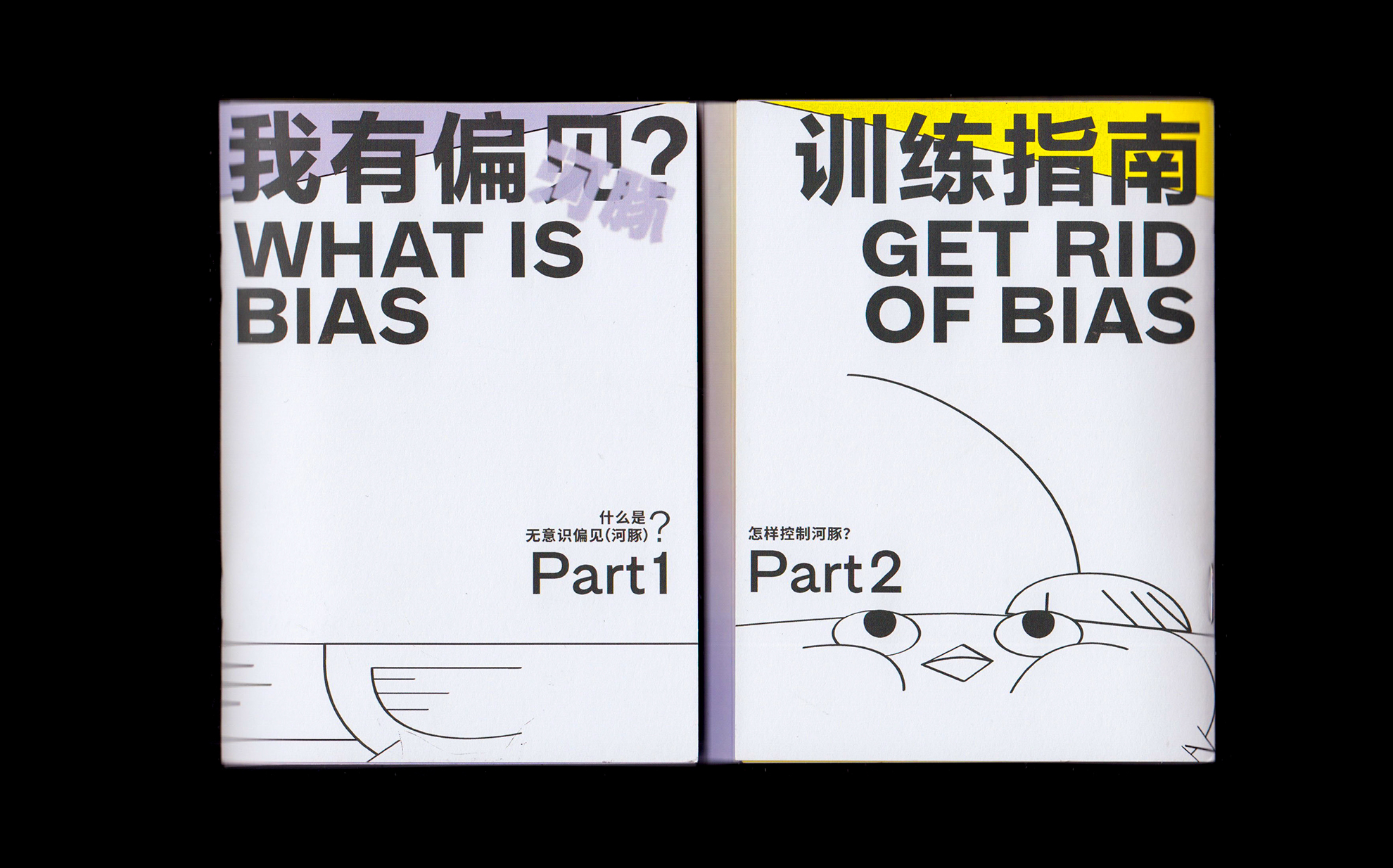


Admit Your Unconscious Bias
通过个人训练来承认你的偏见
反偏见指南设计Design A de-bias book to help individuals
address their
unconscious biases
Project Type
项目类别
Book Design
书籍设计
Illustration Design
插画设计
项目类别
Book Design
书籍设计
Illustration Design
插画设计
Project Contributor
项目人员
Ashur He
项目人员
Ashur He
My Contribution
我的贡献
我的贡献
- Editorial Design 编辑设计
- Binding Design 装帧设计
- Layout Design 排版设计
- Typeface Design 字体设计
- Illustration Design 插画设计
Brief Introduction
This is what happens to us in our daily life.
Some people will think that all women are driving slowly.
Someone we will think they are too fat to self-discipline.
We just can't control it, even speak about it, then develop this concept further even harm those people. Because we don't consciously realize that it is unconscious biased.
Unconscious bias is a quick and often inaccurate judgment based on limited facts and our own life experiences. If we don't understand it well, It will have a disadvantage in our social life.
However, Majorities of unconscious bias training (UBT) are very formal, Only the people who have self-conscious of their unconscious bias willing to take the training, while those who do not think they have bias will not be willing to learn. So, how can visual communication designer do something for it?
My book Getting Rid of Bias: De-bias Guidance is the answer to how visual communication designers help individuals lessen their unconscious bias in China.
The book is classified into two parts, first is teaching people unconscious bias by using pufferfish as a character. The second part is teaching readers how to de-bias by using the step to react and case studies.
This exciting and systematic guidance can successfully help some readers de-bias, supported by my user testing.
Youtube video showcast
项目简介
这是我们日常生活中会发生的事:
有些人会认为所有的女性都开车都很差。
我们甚至还会认为胖的人就是不自律的人。
我们不能控制它,甚至直接就说出来,然后伤害到那些人。因为我们没有意识到这是我们的无意识偏见。
无意识偏见是一种基于有限事实和我们自己的生活经验而做出的快速且往往不准确的判断。如果我们不能很好地理解它,它将破坏我们的社会生活。
然而,大多数的无意识偏见训练(UBT)是非常正式的,只有那些意识到自己无意识偏见的人才会愿意去主动接受训练,而那些不认为自己有偏见的人不会愿意学习。
那么,作为视觉传达设计师可以为这个问题做些什么呢?
我的书《训河豚指南》(Getting Rid of Bias: De-bias Guidance)解答了视觉传达设计师如何帮助国人减少无意识的偏见的研究问题。这本书分为两部分,第一部分是用河豚作为人物来教导人们无意识的偏见的角色。第二部分是教读者如何通过步骤和案例研究去学习怎样减少偏见思维。
通过一系列的用户测试,这本令人兴奋和系统的指南可以成功地帮助一些读者消除偏见。
Bilibili 视频窗口







Phase one
第一阶段The purpose of this phase was to explore the visual transformation of unconscious bias and write the guidance's content. It is a significant milestone of the whole project that determined the visual style and the main character of the unconscious bias.
在编辑部分,我使用了大公司目前的无意识偏见培训作为我的内容支持。
我结合UBT开源培训的优势来帮助我写内容。此外,我把我的个人经验,因为我可以评估他们的有效性,通过我的实验。
为了说明这一点,我首先参加了谷歌和微软团队的UBT培训课程,展示了他们UBT培训的所有步骤。然后我根据我的二次研究重新安排了内容,关于什么UBT需要修改,以及基于什么UBT内容对我来说更有说服力和吸引力。通过这样的内容安排,我可以结合不同UBT培训的优势,生成更有效的自我培训内容。
对于视觉设计部分,我的案例借鉴帮助我知道我应该遵循的一些原则。例如,实践的先例告诉我,一致的视觉语言可以使故事流畅。此外,人们容易记住少于七个角色。而且,角色的样式越简单,越容易记住。
在视觉设计中,主要的挑战是如何选择一个令人难忘的角色来代表无意识的偏见。
在我发现一些动物可能具有相同的无意识偏差特征后,我发现河豚可以匹配所有这些无意识偏差的点,例如由环境激活的恶化过程。无意识地,自然地,平淡而深刻;变形,活在我们的思想里。所以我最终选择了它作为无意识偏见的代表。它生动地展示了刻板印象如何变成无意识的偏见,从而有效地帮助人们记忆。
根据这个特点,我开始做草稿,选择字体和颜色的混合。


Phase two
第二阶段这个阶段的目的是利用用户反馈来帮助我修改我的第一部分的设计内容与结构。这一阶段为我继续设计和修改我的项目提供了必要信息支持。

Phase Three
第三阶段The purpose of this phase was to finish the second part of my guidance and use a user interview to check the total result of my guidance design. This phase is the final testing and modification of my guidance. This testing plays complementary support to the phase two testing.
这个阶段的目的是完成我的指南的第二部分,并使用用户访谈来检查我的指导设计的总体结果。这个阶段是对我的指南内容的最后测试和调整。访谈测试对第二阶段的测试起到了补充支持作用,因为它帮助我了解了更多问题背后的原因。


© Ashur He, 2021
Thanks for watching ︎


